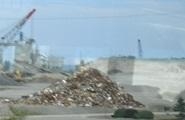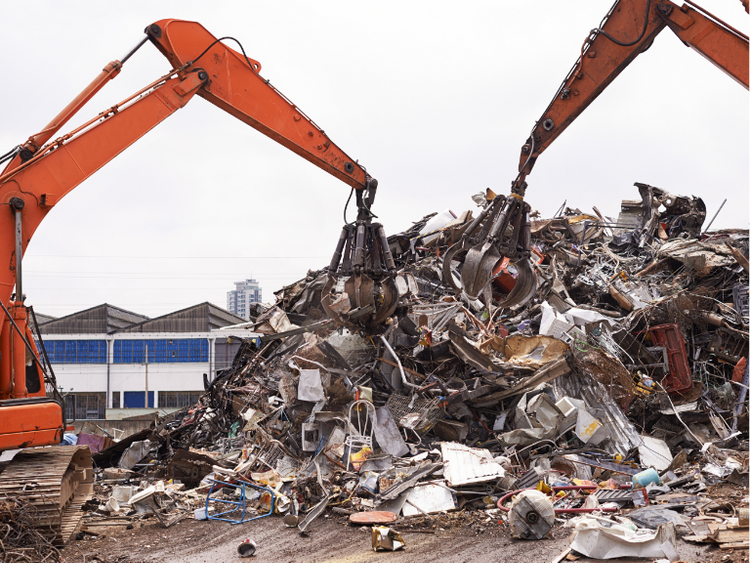Scrap Prices North America

Ferrous Scrap Prices Decline in May, June Unclear
Written by Tim Triplett
May 8, 2018
Ferrous scrap prices have declined a bit in May, reported Steel Market Update sources, due to weakness in the export market and warmer spring weather that aided scrap collection and boosted supplies. Looking ahead to June, sources expect further change, but they disagree on the degree and direction.
In the Ohio Valley, prices declined, but only on obsolete grades by $10 per ton, while primes went sideways, said one dealer. This is a testament to the strong scrap demand in the domestic. Mills are more concerned with keeping pipelines full than quibbling over $10 in the price of scrap, he said. He reports shred at $380 per gross ton, bush at $395 to $410, P/S at $385 and HMS at $370. “Prices in June should remain in this trading range barring transportation restrictions or changes in the international markets,” he said.
A dealer in the Northeast called May ferrous scrap trade “a bit of a roller coaster ride.” Initial sentiment saw the market down $10 to $15 for obsoletes and a little less for prime. That sentiment was replaced just before the end of April with a more bearish tone and obsolete grades down $20 to $30. As the trading wore on last week, he said, obsolete grades finished down around $10 to $15, a little weaker in the South and East. Prime scraps were considerably stronger with the Midwest and Southern markets trading sideways. Export has bottomed, at least for now, he said. Current delivered levels from the U.S. to Turkey are around $357 per ton for 80/20 grade.
“I see trading into June being steady or even a bit stronger,” he predicted. “U.S. demand is very firm. The Nucor DRI plant will be down for maintenance in June, and there is anticipation that the prime scrap generation could weaken seasonally in July and August with retooling periods for manufacturers.”
John Harris, president of Aaristic Services, Inc., said May pricing was more subdued than expected as most people anticipated that scrap supply would outstrip demand as a late spring finally arrived. “It is probably a combination of poor transportation with excess inventory on rail in transit and possible high inventories in steel plant scrap yards,” he said. Delivered scrap prices for May dipped to: busheling at $375 to $385 per gross ton, shred to $370 per ton, #1HMS to $325 to $335 per ton, and 80:20 HMS delivered to docks for export at around $300 per ton. Expect June scrap prices to decline again by $10 to $15 as demand from Turkey is affected by Ramadan and U.S. Section 232 tariffs, he said.
Scrap guru Mike Marley of World Steel Exchange Marketing said ferrous scrap prices vary depending on the locale. No. 1 heavy melt ranges from $340 to $360 per gross ton, averaging $345. Shredded is $365 to $380 per ton with the average at $375. Both are off by $10 to $20 per ton from April’s levels, he said.
The biggest declines occurred in the East and Southeast, largely because of the slower pace of export sales, both bulk cargoes and containers. Also, the export yards cut their buying prices by about $10 per ton. Because of the slower pace of offshore sales, some exporters and coastal scrap yards offered more scrap to the mills in the Southeast, either by barge or rail. That helped to drive down the prices by as much as $20 per ton in that region. Also, obsolete scrap is flowing into dealers’ yards at a steady pace, which is expected this time of year. Demolition projects are under way and the peddlers are busy picking through dumpsters, he said.
Busheling and bundles were unchanged in most regions. There were a few isolated buys at lower prices, but overall most of the prime industrial steel scrap prices went sideways, for a couple reasons. First is the ongoing challenge of getting enough railcars and trucks. Several mills are still owed thousands of tons of scrap, including obsolete grades like heavy melt and shredded, as well as the bundles and busheling. Without the transport problems, we might have seen steeper drops in the obsolete scrap prices, but I’m not sure we would have seen much of a decline in the busheling and bundles tags. That’s why some of the bigger scrap users did not cancel many of their undelivered orders at the end of April. And it possibly was another reason the prices for busheling and bundles did not change. If one mill cancelled its unshipped orders and cut prices, dealers could then ship that scrap to the mills they still owed a lot of prime scrap and were willing to pay last month’s prices, Marley said.
Another reason, according to some scrap traders, was the mills’ recognition that if they dropped the bundles and busheling prices, it could have two impacts. First, steel users might demand matching or deeper cuts in the sheet prices. Second, the busheling price premium over shredded scrap had narrowed in April to as little as $5 or $10 per ton in some regions. That might be enough to encourage some integrated mills and other EAF-based steelmakers to change their melt mix and use more bundles and busheling. The metal recovery rate for bundles and busheling is about 95-98 percent, versus only 90 percent for shredded. In other words, for another $5 per ton they can get more metal from each ton of scrap melted, he explained.
Looking forward to June and July, industrial scrap flows will slow and affect the supply, he continued. In the summer, the auto industry will shut down stamping plants on a rolling schedule for vacations and to retool the stamping presses to make next year’s models. Normally, they shut down each plant for about a week, but for some that are making the slower-selling models, that could mean two-week closures. Because of the shutdowns, the steel industry usually figures on a loss of 25 to 30 percent of the steel sheet scrap that it normally gets from the automakers each month. Since the flat-rolled mills have been running so well for the past six months, they have not been able to amass much industrial scrap as inventory at their mills.
The outlook for exports is still mixed, Marley added. Some think the Turkish mills need more scrap and have drained the supply lines in western Europe and the Baltic Sea regions. U.S. exporters have cut the prices they are offering local dealers, but they apparently have not cut their price offers to the Turks. While many market observers focus on the Turkish demand, they forget that U.S. East and Gulf Coast export yards do a lot of business in Mexico, South America and the Middle East. That comes on top of the demand from the domestic mills in the Southeast, which they can reach by both rail and barge. And they are not having the barge shipping problems that dealers in the Midwest have endured in the past few months and now face because of the grain shipping season.

Tim Triplett
Read more from Tim TriplettLatest in Scrap Prices North America

HRC vs. prime scrap spread widens in June
The price spread between HRC and prime scrap widened in June.

Ferrous scrap pricing sideways in June
Ferrous scrap prices in the US have remained stable from May to June.

HRC vs. scrap spread widens over $150/ton in March
The HRC vs. prime scrap spread increased again in March.

HRC vs. prime scrap spread increases in February
The price spread between hot-rolled coil (HRC) and prime scrap widened in February ahead of the implementation of President Trump’s tariffs on steel.
HRC vs. prime scrap spread narrows again in January
The price spread between hot-rolled coil (HRC) and prime scrap continued to narrow in January, according to SMU’s most recent pricing data. While SMU’s average HRC price edged down week over week (w/w), it rose compared to a month ago. The January price for busheling also increased from December. Our average HRC price as of […]
